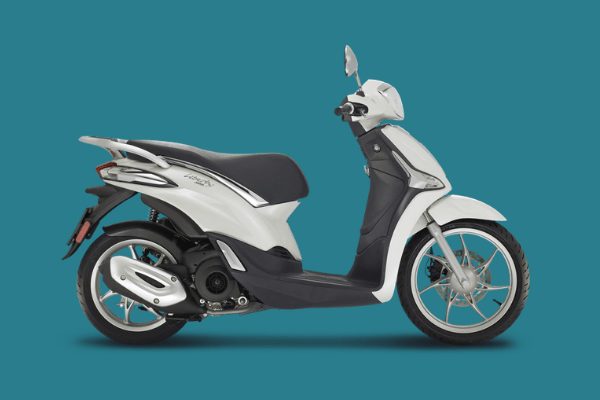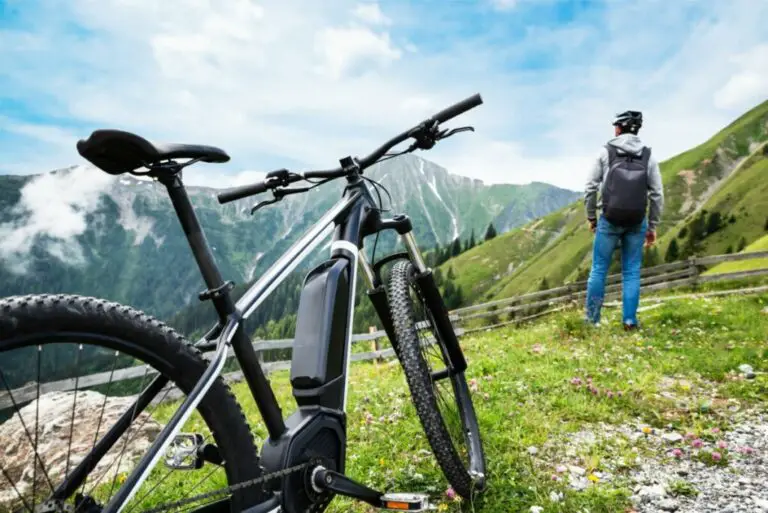In a world where there are so many choices for everything, adding yet another choice to figure out what’s best or even just different in the moped vs scooter vs motorcycle debate presents yet another fork in the road. This isn’t just about picking a mode of transport. It’s your daily commute, a way to have adventures, and there is the undertone statement of your lifestyle.
We’ll compare some specs & features, but we’ll also compare how each of these two-wheeled options stand up to your demands. Whether you see yourself weaving through city traffic, going on long adventures, or simply finding a cheap way to get where you need to go, this guide lays it all out.
Key Takeaways
There is overlap between mopeds, scooters & motorcycles, but in general, you’ll find the following to be pretty true:
- Mopeds are the smallest and least powerful of the three, typically having engines at or below 50cc, making them ideal for short distances and lower-speed zones.
- Scooters offer a step-through frame accompanied by a foot platform. Their engines range from 50cc to 650cc, appealing to riders seeking ease of use, maneuverability, and greater fuel efficiency.
- Motorcycles are generally the most powerful two-wheeled vehicles, with larger engines and higher top speeds, making them perfect for highway travel and long rides.
Let’s dive into what sets each apart, from handling and comfort to performance and practicality, to make your decision an easy one.
Moped vs Scooter vs Motorcycle Overview
Understanding the Basics: Defining Moped, Scooter & Motorcycle
Let’s talk about each separately so that you’ll get the practical implications of choosing between a moped, scooter, or motorcycle. Each offers unique advantages and challenges, tailored to different needs and lifestyles, but there is also some overlap between them. Don’t worry! After we walk through each individually, we’ll talk about how differences translate into everyday use.
What is a Moped?
A moped is a lightweight, low-powered two-wheeled vehicle typically equipped with an engine size of 50cc or less, and often has pedals for human-powered propulsion. The pedal versions are more like a bicycle-type vehicle. Some mopeds may have a small motor, but their maximum speed is usually under 30 mph (48 km/h).
Mopeds are designed for urban or short-distance travel, and their small, fuel-efficient engines make them cost-effective transportation options. Key features of mopeds are:
- Engine size: 50cc or less
- Top speed: Under 30 mph (48 km/h)
- Pedals: Many models have pedals
- Wheel size: 10 to 16 inches
- Transmission: Can be manual or automatic
- Riding Position: Upright
I can’t help but also mention that technically, mopeds have pedals. Moped is an acronym for for “motorized pedals”. It’s like an electric bike but with a motor – electric or gas-powered.
That said, many people use the term moped to refer to scooters in general or at least scooters with the smallest engine sizes. For the remainder of the article, I’ll refer to mopeds as the bicycle-type vehicle with motorized pedals & those without, I’ll refer to them as scooters. More on how 50cc scooters are different than e-bikes here
What is a Scooter?
A scooter is a type of two-wheeled vehicle that has some overlap with mopeds and motorcycles in terms of specifications. They are usually powered by an engine between 50cc to 550cc. I mentioned above, some people unknowingly call 50cc scooter mopeds & larger models, think a 300cc scooter or larger, are sometimes called maxi-scooters.
Plus, all of the official agencies like your department of motor vehicles & insurance companies classify scooters as motorcycles. You read that right! If your state mandates a motorcycle endorsement, it can apply to riding scooters.
There is a obvious main difference from mopeds vs scooters vs motorcycles – Scooters usually have the ‘step-through’ chassis design with a footrest platform, but true pedaled mopeds and motorcycles have riders throw their leg over the seat to get on. The step-through lets you easily mount and dismount by stepping through the frame.
Another key difference is the storage on a scooter. There is a storage box that can fit at least a 3/4 helmet usually if not 2 depending on the size of the scooter that you won’t find on a true moped or motorcycle. Key features of scooters are:
- Engine size: 50cc to 550cc
- Transmission: Typically automatic or continuous variable transmission (CVT), particularly on modern scooters.
- Chassis design: Step-through (but not always)
- Wheel size: 10 to 16 inches
- Fuel economy: Highly efficient, suitable for urban commuting
- Riding Position: Usually upright with some more reclined options
What is a Motorcycle?
A motorcycle is a two-wheeled vehicle known for its power, speed, and long-distance capabilities. They come in various styles, including cruisers, sport bikes, and touring models, each designed for different riding experiences. Motorcycles are generally larger and more powerful than scooters and mopeds, but they do start at 50cc, too, depending on who you ask. Think mini-motorcycles like Honda Navi.
The riding position you are in when sitting on motorcycles can vary significantly: cruisers often feature a more reclined posture, with the rider sitting back, legs forward, and hands raised to a comfortable height, while sportbikes have a more aggressive, forward-leaning position. Key features of motorcycles are:
- Engine size: Typically above 250cc, can go up to 1000cc or more
- Transmission: Usually manual with a clutch & shifter
- Riding Position: Varies from reclined (cruisers) to forward-leaning (sport bikes)
- Wheel size: 16+ inches
- Fuel economy: Varies based on model and engine size, generally less fuel-efficient than scooters and mopeds based on the engine size
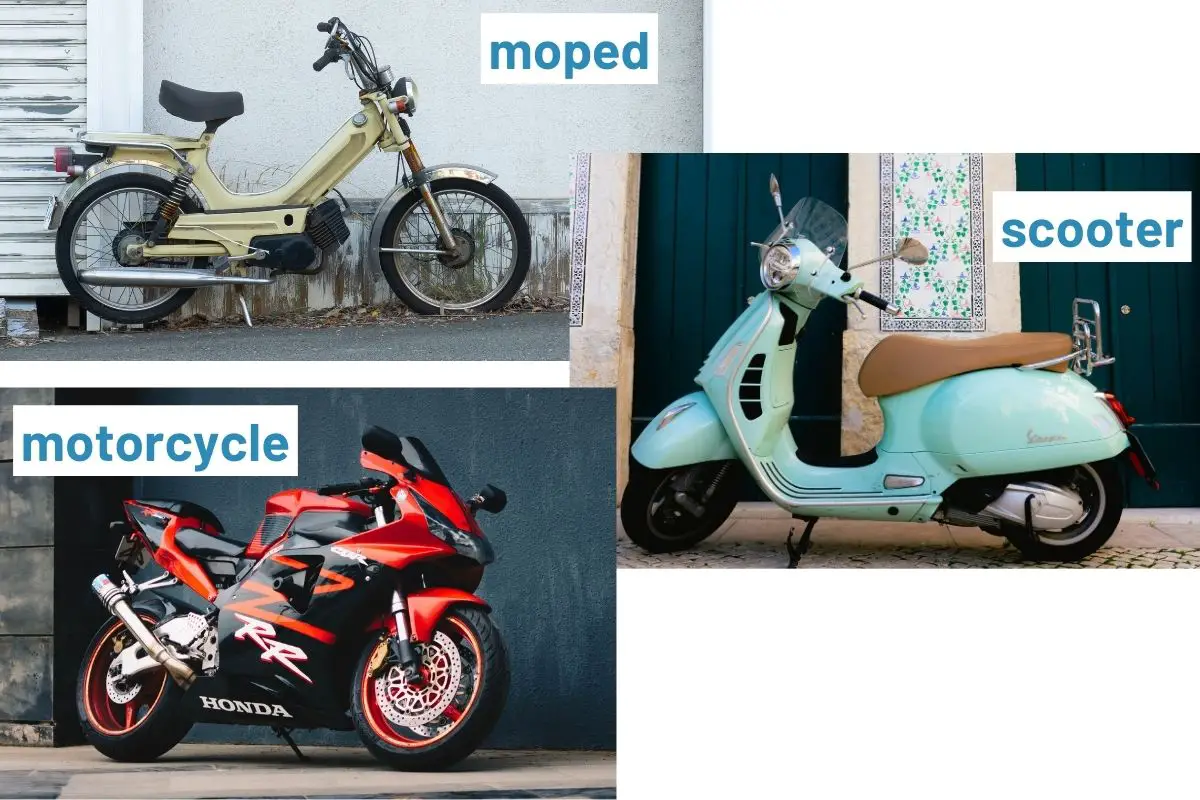
Performance & Use Cases
When it comes to performance, both scooters and motorcycles have their unique strengths. Scooters are known for their maneuverability while motorcycles are known for their power. It just isn’t that simple, though!
Engine Size and Power
When you think of a motorcycle, you tend to think large motors meant for higher speeds and a scooter is likely to make you think of small motors designed for slower speeds. That’s partially right, but it is not 100% true!
Brief newbie explainer: Engine sizes are measured in cubic centimeters (cc) which refers to how much it can displace fuel to turn it into power. The lower the value, the lower the top speed you can expect and the higher the number, the faster we are talking. Generally.
- Motorcycles and motorbikes have engines sizes from 50cc to over 2000cc. The highest speed of a 150cc engine is about 60 mph or 97 kmh. You’ll find most on the road to be in the 750-1100 cc range, but you’ll hear that beginner bikes are in the 500-750cc range.
- Scooters, on the other hand, have an engine with sizes that ranges from 50cc to 550cc available new. A scooter with an engine of 50cc can’t be described as one designed for speed since you’re looking at the 30-45 mph max range. Check out this article if the 50cc speed limit has you curious. However, a 550cc scooter is designed for higher speeds with a bigger frame, bigger tires & all the features that make travel on a highway just like a motorcycle.
A 50cc scooter is best used within the city whereas the 1000cc motorcycle can cruise along just fine on a highway next to a 550cc scooter. The 550cc scooter won’t win that race, though.
Speed
The speed of a scooter vs motorcycle depends on the type of engine the scooter or motorcycle has. Regardless of whether you’re looking at a motorcycle or scooter here, the speed is dictated by the engine size.
There are a lot of factors that influence the speeds of each individual motorcycles and motor scooter engines, so it isn’t cut and dry. That said, below are some generalized guidelines to expect for a top speed REGARDLESS of if you’re talking scooter or motorcycle.
- 50 cc = ~ 40 mph (if not restricted to 30 mph)
- 150 cc = ~70 mph
- 200 cc = ~75 mph
- 300 cc = ~85 mph
- 400 cc = ~90+ mph
I was checking out a Honda Rebel 300cc motorcycle recently, and in chatting with the sales person & doing some research, the 300 just doesn’t have the power. It seems hands down that experienced riders recommend the 500cc at a minimum if you’re looking to travel on the highway. I point this out because the 300 cc has a top speed of about 85 mph sound like it should be more than fine on the highway. There’s more to it as part of the key differences.
The key takeaway here is that you can find slower or faster options in both categories – scooters and motorcycles.
Wheel Size and Stability
The wheel size determines how stable the wheels will feel when the moped vs scooter vs motorcycle is going at it’s top speed speed.
- Motorcycle wheels are generally 16” or larger. This makes the motorcycle a lot more stable when riding at a higher speed & able to handle trash in the road that you might come across.
- Mopeds and scooters have a wheel size ranging from 10” to 16”. The wheel size of scooters is small and this makes the scooter relatively unstable when at high speeds but just right for the speeds they’re designed for.
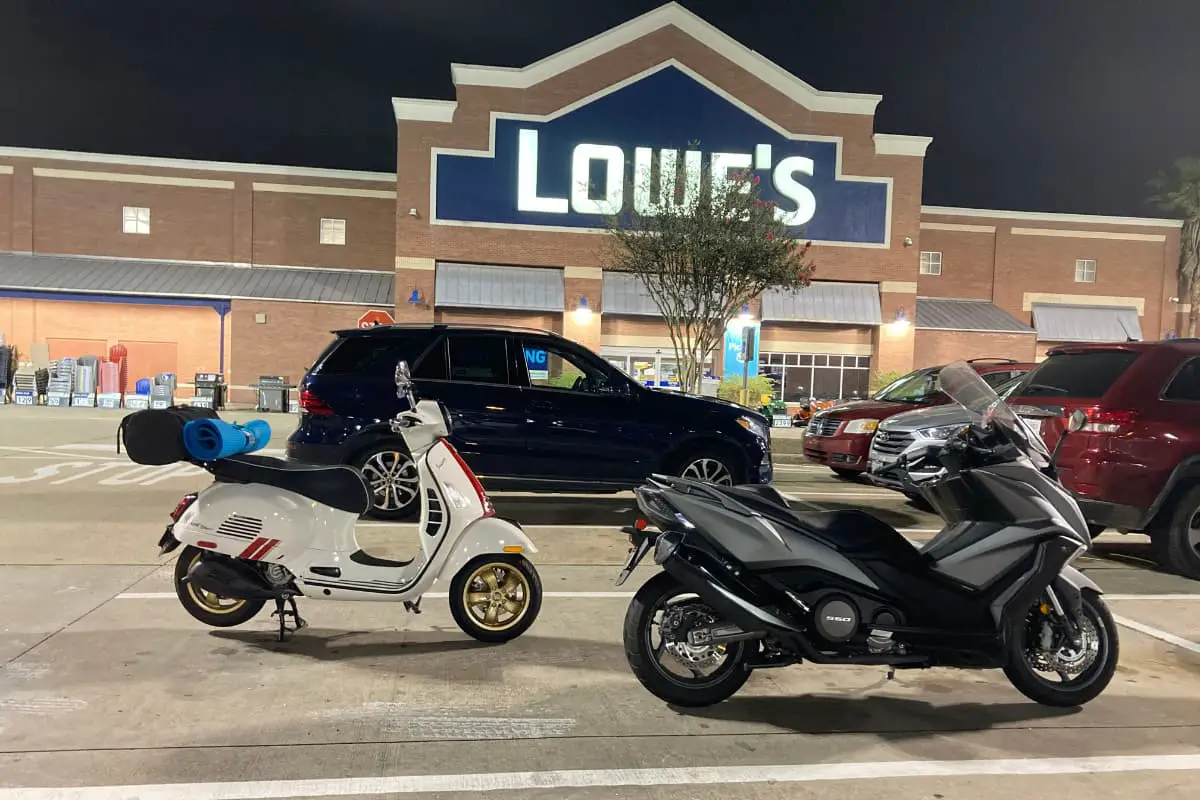
Fuel Efficiency Comparison
There are now electric versions of mopeds to motorcycles, so that’s a whole new ball-game. For gas-powered options, mopeds have the best fuel efficiency. Scooters have better gas mileage in the motorcycle vs scooter debate. You’ll find that scooters can get anywhere between 60 to 100 miles per gallon (mpg) depending on the model. In general, know that the engine size will tell you more about the fuel efficiency because a 500cc scooter & 500cc motorcycle will be very similar.
The engine size also translates to fuel efficiency. In general, the bigger the motor, the more gas it will use compared to a smaller motor option. Since most scooters on the road have a smaller engine size, you’ll find them more fuel efficient, as well.
Here’s a quick comparison of fuel efficiency between a scooter vs motorcycle:
| Vehicle Type | Fuel Efficiency (mpg) |
|---|---|
| Scooters | 60 to 100 |
| Motorcycles | 30 to 70 |
City Commuting
For city commuting, scooters stand out for their maneuverability and easy handling. The combination of a step-through design, foot platform, and automatic transmission makes them particularly user-friendly and comfortable for daily city rides. They’re generally more affordable and require less maintenance, thanks to their smaller engines. Plus, they beat out both mopeds & motorcycles with built-in storage. There is a box under the seat that can usually fit smaller helmets & sometimes another box on the front.
However, if roads you travel on have generally low speeds, mopeds can be the ultimately transportation hack. They’re essentially a motorized bicycle, so they excel in environments where lower power and speed are advantageous, such as crowded city streets. Their compact size and fuel efficiency make them ideal for short trips and running errands.
- Small engine size = best gas mileage
- Small frame & smaller wheels = nimble & easy to park
- Great for shorter trips on routes with low speed limits
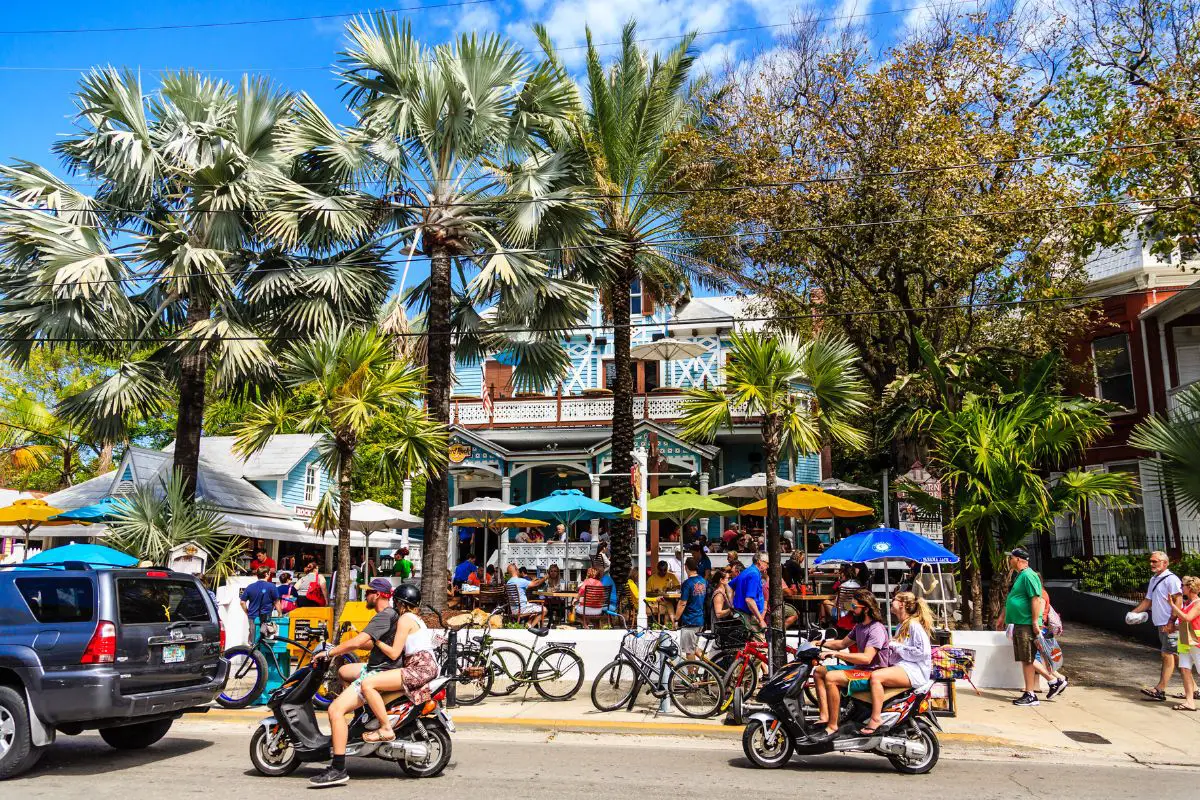
Long-Distance Travel
Motorcycles are the obvious choice for long-distance travel. While you can find a high cc scooter, most motorcycles that aren’t a mini-moto start at 300 cc engine which gives you the sustained power and speed for highway travel. It’s more than just increased power, though. The larger wheels on motorcycles will add to your stability at higher speeds & better able to handle any junk when you’re on the open road. Oh, and you’ll appreciate the larger gas tank in between fill-ups, too!
For occasional long trips, consider maxi-scooters. These larger scooters provide more engine power and storage than traditional scooters, making them a possibility for longer trips.
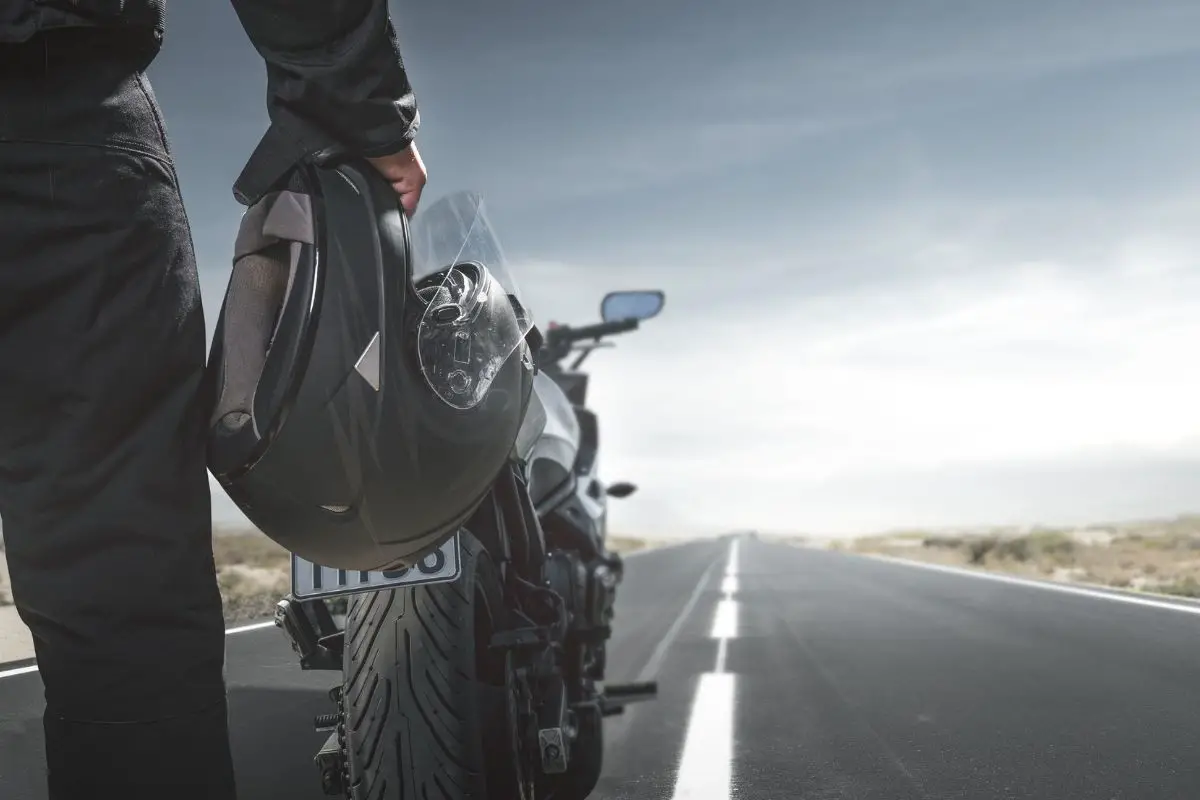
Racing and Sport
Motorcycles are the clear choice for racing and sport riding. Designed for high performance, they offer the necessary power, suspension, and speed capabilities for racing and sporty riding, especially in closed tracks or challenging terrains.
While scooters and mopeds are fun, it’s in a different way. They don’t have the performance features required for racing or high-speed sport riding.
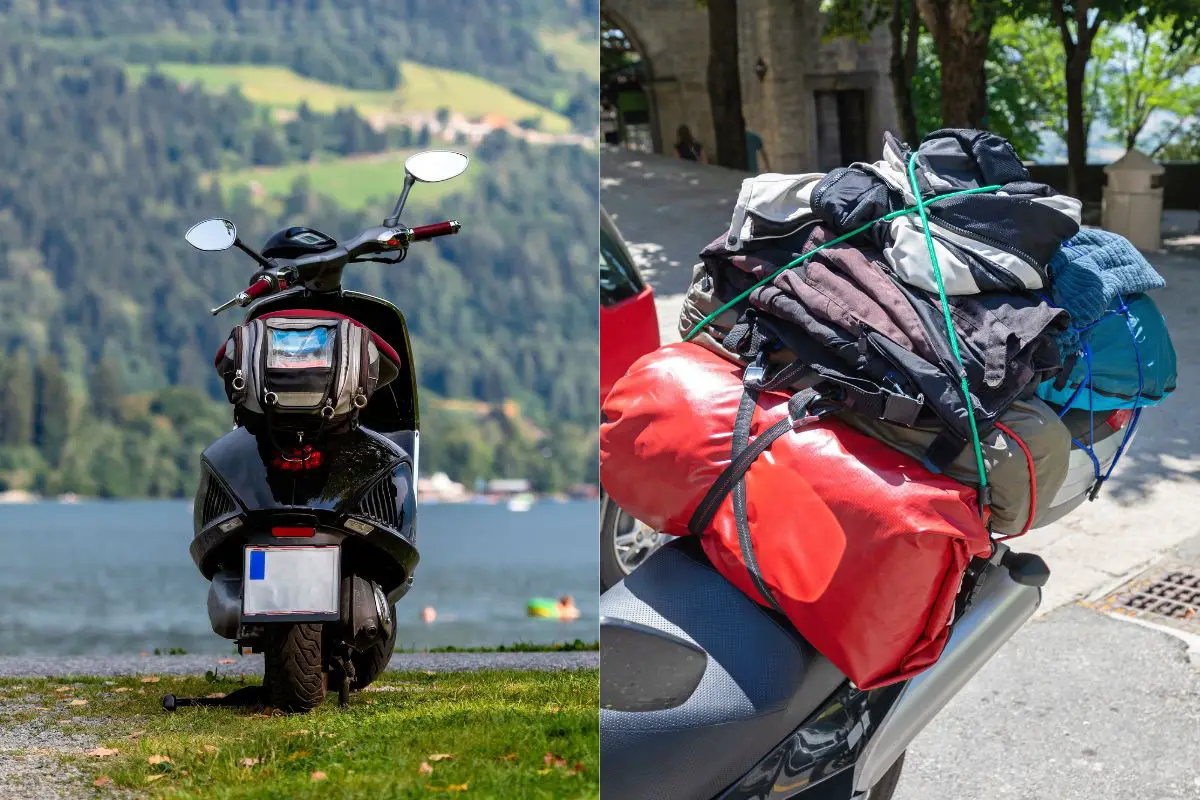
Cost Differences: Moped vs Scooter vs Motorcycle
When thinking about what matters to you, hopefully you were starting to think through how much the differences might cost you. There is the cost of the moped, scooter, or motorcycle PLUS insurance, licensing, and don’t forget – maintenance.
Initial Purchase Price
In general, scooters tend to be more affordable than motorcycles. You can find a quality scooter for around $1,000-$3,000, while a good motorcycle typically starts at $4,000 and goes up from there.
Engine size matters a lot in pricing whether you’re looking at a scooter or motorcycle. A 50cc scooter can technically be purchased on Amazon like these 50cc TaoTao scooters for much less than you’d think a transportation source could cost.
However, if you stick with a reputable brand with a dealer supported warranty, they generally start at $2,000 for the smallest engines (& therefore lowest speeds). On the other side of this, the most powerful scooter available right now has an MSRP around $10K (Kymco AK 550 review here).
For motorcycles, I was recently checking out a Honda Rebel 300 – and it runs at just under $5k MSRP. A Vespa GTS 300 is quite a bit higher than that with the same engine size. So you’ll find a lot of overlap in the price ranges.
I then visited a dealer to look at an Indian Motorcycles Scout Bobber. It’s just over 1,100 cc and starts at over $11K Then the Elite models with a starting price of $38,999!
You’ll find a lot of overlap and nuance when you layer in engine sizes, brands, and much more. That said, I have yet to run across a scooter in $20,000 range! With that, it is easier to keep costs down with a scooter, but there are plenty of motorcycles on the lower end of the price range. It all depends on your needs!
And for mopeds, I can’t find a new, gas-powered one offered in the United States. The lowest for an electric motor that I’ve seen is ~ $600 while the higher end versions can reach up to $10,000.
Maintenance and Repairs
Maintenance and repair costs tend to be lower for mopeds and scooters. This is mostly because they have smaller engines and slightly fewer components. Typical maintenance tasks include oil changes, tire replacement, and brake maintenance.
Motorcycles, on the other hand, usually require more frequent and expensive maintenance due to their larger, more powerful engines and more complex components. They’ll have the same typical maintenance like scooters, but motorcycles also have valve adjustments, chain and sprocket replacement, and more. Costs can vary depending on the specific brand & model for sure!
But it was a surprise to me to bring in my scooter at 600 miles for it’s break-in maintenance, so budget for that!
Insurance and Taxes
Motorcycle insurance costs for mopeds & scooters are typically lower than motorcycles due to their smaller engine sizes, value, and generally lower risk factors assumed if your top speed is 45 mph. And yes, if you need insurance from a moped to motorcycle, it’s called motorcycle insurance.
Just know that there is more to insurance costs like your age, your vehicle’s age, driving history, and the specific make and model of what you’re insuring.
Any vehicle that can be driven on the road requires proper licensing and registration. Although the process may be different depending on your state, some states do not require any special license beyond a drivers license depending on the engine size of a scooter. Think 50cc here, but that’s more of a rarity.
When buying either a scooter or a motorcycle, you’re going to have additional costs before you drive up – whether new or used. Are you legally able to ride with the appropriate license requirements for your state? Liability insurance requirements? State transfer for the title? Yes, even scooters have titles.
Legal Requirements
When considering whether to purchase a scooter vs motorcycle, you’ll want difference between scooter and motorcycle legal requirements.
First, licensing differences may be a big deal for you. In many states, you will need a specific motorcycle license to operate a motorcycle, while a scooter may only require a standard driver’s license, depending on engine size. 50cc is where the gray area is for a motorcycle license. Some states also layer in speed caps which is why manufacturers artificially restrict some 50cc.
Traffic laws are another aspect to consider. The rules of the road apply to all vehicles on the road, but things like minimum speed requirements can impact the type of vehicle you can operate in that area. For example, you are likely to find that your state won’t allow your 50cc scooter to be on a 55mph minimum highway.
Legal age restrictions can also vary between local laws. In some locations, you may be allowed to operate a moped or scooter on public roads at a younger age than a motorcycle. You’ll want to double-check the specific age requirements for your area. If you’re young, a moped or 50cc scooter might be just the thing for you!
Scooter vs Motorcycle for Beginners
Riding on 2 wheels is generally going to feel the same when you get going. However, it is a bit easier to just hop on & go on a scooter. You’ll hear scooters referred to as twist & go for a reason.
Most motorcycles are manual. Most scooters are automatic. However, older scooters have manual transmissions, & there are automatic transmissions on motorcycles, too.
When I say automatic, it’s referring to no shifting of gears on your part. The motor does what it needs to do. You twist your right handlebar & it will go. When it isn’t automatic, there’s more to do as you’re riding along.
Both of the leavers by your hands on the handle bar are then for braking on a scooter.
The levers on a motorcycle handlebar are a bit different. The left lever is the clutch, and the shifter is the left foot. The right lever on the handlebar is a brake as is the foot control. So the left side of your body makes the motorcycle go. The right side is your braking.
To brake, you’re expected to apply both brakes evenly. This feels smoother on a scooter with the brakes both being hand operations.
And don’t get me started on the idea of the motorcycle riders that act like you’re not legit if your bike is automatic. Dude. Were you around in the 80s when people said the same thing about transmissions in cars & trucks? 🙃
Which is Better? Moped, Scooter or Motorcycle?
In general, people choose scooters to save money, need something with a lower speed, or want something easier to learn to ride on. Some are also attracted to their looks & twist-n-go – LIKE ME!
In general, motorcycles are more popular than scooters due to their speed and styling.
The visual difference between motorcycles in general and scooters is very striking. You can find motorcycle-like scooters and mopeds, but many have the classic, Italian Vespa styling, which does not attract the same buyer of a Harley Davidson.
Also, United States highways are really how we get from point A to point B, and many scooters just aren’t equipped to go long distances at high speeds. Some can but most can not.
There are also motorcycles intended for some gravel/off road like paths called adventure bikes. Right off the bat you’ll noticed that they have knobby tires which scream to be taken on an adventure. Thus the name!
Your circumstances, needs and budget really drive which would be better for YOU!
| Factor | Scooter | Motorcycle |
| Engine Size | 50-650 cc | 250+ cc |
| Transmission | Automatic shifting | Manual shifting with a clutch |
| Wheel size | 10-16” | 16”+ |
| Shape | Rider sits with feet on step-through platform | Rider sits astride, requires leg swing over the motorcycle |
| Engine Location | Rear and attached to rear suspension | Middle and attached to the frame |
| Requires Special Licensing | Depends on state when 50cc usually a full yes when over 50cc | Yes |
Is a Scooter Safer than a Motorcycle?
Scooters are not actually proven to be safer than motorcycles, but in general, the slower speeds of scooters make the risk of serious injury and death to be less when wearing appropriate gear and responsible riding.
Scooters typically have a lower speed range and can get around obstacles easier. However, riding on 2 wheels without the protection of a car frame leaves a scooter rider just as vulnerable as a traditional motorcycle.
If a scooter vs motorcycle rider is hit at 50 mph with all other circumstances exactly the same, the results are the same.
So the slower speeds of a 50cc make it feel much safer, while the opportunity for disaster is the same even if you won’t find yourself riding at highway speeds on that same 50cc.
I like how Francois from Adventure Bike Troop summarized a study on the safety between mopeds, scooters & motorcycles:
“Studies show that scooters are less likely than motorcycles to be involved in a single-vehicle accident or where the rider is at fault. There is no proof that scooters are safer than bikes, but scooter riders tend to take less risks. While non-riders perceive scooters as being safer, most motorcyclists feel less safe on a scooter.”
Mopeds vs Scooters vs Motorcycles Takeaways
If you’re looking for a more affordable, lightweight, and fuel-efficient option that is easy to maneuver in a city-ish area, a scooter might be the ideal choice for you. They usually have lower top speeds, which makes them perfect for short commutes and running errands around town. If your speeds are seriously low, a moped is the cheapest way to do to this.
On the other hand, if you prefer a vehicle with a higher top speed, more power, and better stability at higher speeds, a motorcycle could be the better option. Motorcycles are suitable for long distance rides and highway travel, offering a greater sense of freedom and adrenaline rush for thrill-seekers.
If you like the looks of one over the other – that’s the best for you!
For me, it comes down to this:
- Budget: Scooters tend to be cheaper to purchase and maintain, while motorcycles can have a higher upfront cost and ongoing expenses.
- Riding experience: Beginners may find scooters easier to ride due to their automatic transmission and lighter weight, while experienced riders might enjoy the versatility and power of a motorcycle.
- Usage: Think about your daily commute, the type of roads you’ll be traveling on, and whether you’ll be doing mostly city riding or long distance trips.
Ultimately, the choice between the 2-wheeled options is a personal one. Weigh the pros and cons, test ride them all for fun, and go with the one that meets your needs AND you feel most comfortable and confident on!



